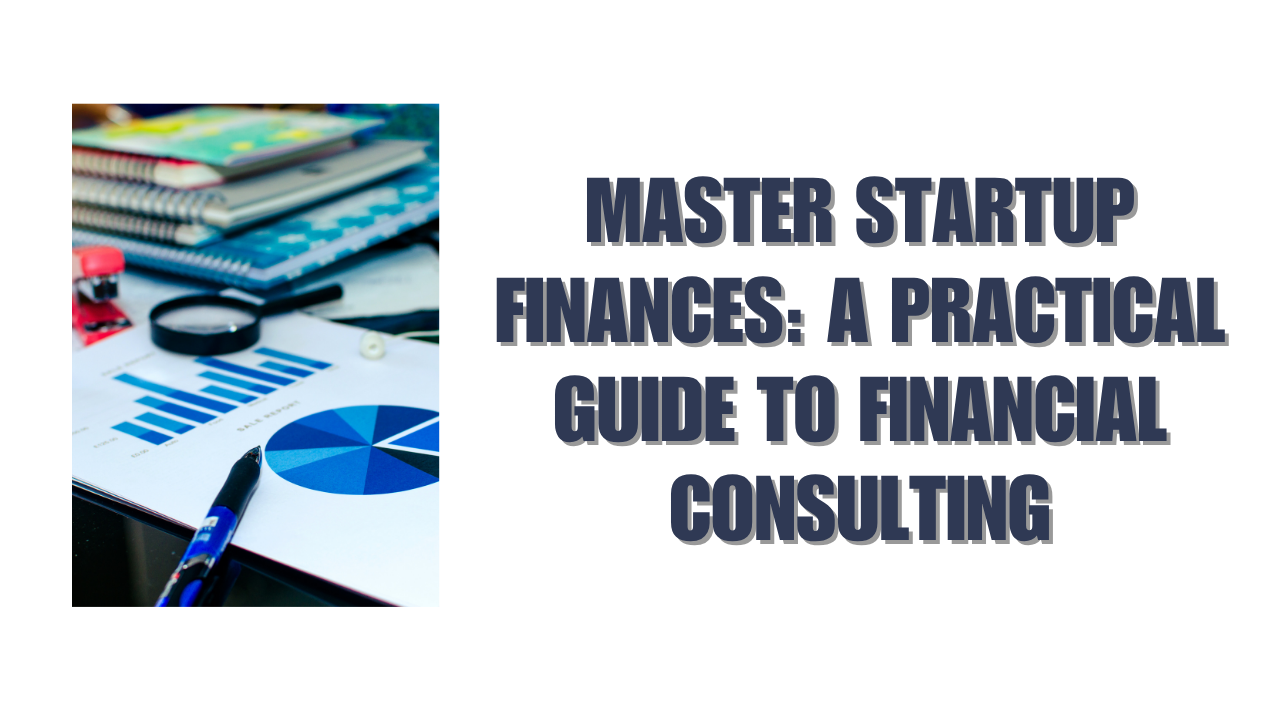Startups raising seed funding between 2020 and 2023 saw a median deal size of $3.9 million. Financial consulting has become crucial for startups, as seed funding makes up over 80% of pre-Series A funding raised by companies that reached Series A in 2023.
The looming recession and uncertain economic climate make a solid financial model necessary, not just optional. A good financial model serves as your budget and tells different teams about expected hiring needs, major expenses, and financial targets. Becoming skilled at financial modeling matters even more because early-stage companies spend most of their money on people.
Most founders use a mix of funding sources to build their early prototypes. These typically include personal savings, support from friends and family, or grants. Your investments could run dry before your startup gains any real momentum without proper financial planning.
Let’s explore everything in financial consulting that your startup needs to master. We’ll cover setting clear KPIs, building realistic forecasts, and creating financial models that deliver results.
Set Clear Financial Goals and KPIs
A solid financial foundation makes the difference between startup success and failure. Financial KPIs work just like your car’s dashboard – they let business leaders see the big picture and spot urgent problems.
Define your startup’s financial vision
Your financial goals build the foundation of your success roadmap, both inside and outside your organization.
The first step is to create SMART financial goals – Specific, Measurable, Achievable, Relevant, and Time-bound. To cite an instance, rather than a vague “increase profits,” set a target like “boost monthly net profit by 15% within six months”.
Your financial goals should naturally blend with your overall business strategy and reflect your company’s values, mission statement, and long-term vision. When you break these goals into smaller, achievable milestones, they become less daunting and create chances to celebrate small wins.
Choose 3-5 key performance indicators
Companies do better when they track no more than 10 KPIs – startups work best with 3-5. Your company’s goals, business model, and specific operating processes determine which KPIs you should pick. Different businesses need different KPIs:
- Foundation stage startups need to track customer acquisition cost, runway rate, and burn rate
- Survival stage companies should watch customer retention rate, churn rate, and monthly recurring revenue
- Market-fit stage businesses must monitor customer lifetime value to acquisition cost ratio (LTV/CAC) and annual recurring revenue
Your KPIs should be measurable, based on trackable goals, and expressed as ratios, percentages, or rates.
Arrange KPIs with business milestones
Your KPIs must grow with your startup through different stages. Early-stage startups should prioritize foundation, survival, and market-fit metrics. Here’s a practical rule: when your customer lifetime value divided by customer acquisition cost falls below three, you might need to rethink the business model.
Most investors get worried when the payback period – time to recover customer acquisition costs – stretches beyond 12 months. Expert analysis shows that understanding your startup’s unit economics reveals your path to profitability.
Your KPIs and specific business milestones create a practical roadmap based on real data. Whether you track financial health, customer acquisition, or operational efficiency, the right KPIs show your startup’s progress and highlight improvement areas clearly.
Build a Forecast Using Bottom-Up and Top-Down Approaches
Financial projections need a strategic approach to forecasting. Successful startups use both top-down and bottom-up methods to develop realistic financial models. These models strike a balance between ambition and practicality.
The difference between top-down and bottom-up forecasting
Top-down forecasting begins with a macro viewpoint by perusing the total market size before narrowing down to your potential share. This approach starts with industry estimates and refines them into targets for your specific company. Bottom-up forecasting takes a micro view and starts with internal company data like sales figures or operational capacity.
The main difference lies in the viewpoint – top-down shows what’s possible in the market, while bottom-up reveals what you can achieve with your current resources.
Internal data helps estimate revenue and costs
Bottom-up forecasting needs accurate financial information from sources of all types. Historical performance data, income statements, balance sheets, and cash flow statements form the foundation. Your next step identifies sales segments and maps client acquisition channels. Revenue projections should track metrics like customer acquisition costs, new client quotas, conversion rates, and churn rates. This detailed approach makes you think hard about resource allocation.
Market size and growth assumptions matter
The TAM-SAM-SOM model offers a framework for top-down market analysis. Your first step defines the Total Addressable Market (TAM). Next, calculate your Serviceable Addressable Market (SAM) as a percentage of TAM. The final step determines your Serviceable Obtainable
Market (SOM) – your realistic market share. This process helps verify your revenue potential against broader market opportunities.
Finding the sweet spot between realism and ambition
Ernst & Young suggests using bottom-up forecasts for shorter terms (1-2 years) and top-down for longer horizons (3-5 years). This combination helps prove near-term targets while showing the ambition investors want to see. Note that overly ambitious projections hurt your credibility with stakeholders, but being too conservative might make you overly cautious. The best forecast presents numbers that stakeholders find believable yet exciting enough to spark interest.
Create a Financial Model That Works
A reliable financial model is the life-blood of sound startup financial planning. Your financial model acts as a roadmap that helps you make critical decisions about growth, spending, and fundraising.
Start with a financial modeling template
Templates that match your business model make more sense than starting from scratch. Different business types – SaaS, marketplace, ecommerce, or service-based companies have accessible templates online. A template will save your valuable time and resources and make sure you don’t miss critical components. Pre-built formulas in these templates help you avoid calculation errors.
Include revenue, expenses, and headcount projections
Your financial model must account for all revenue streams and cost structures. Revenue projections should multiply expected units sold by price per unit and adjust for market conditions and historical data. Expenses fall into two categories: fixed (rent, insurance, administrative salaries) or variable (costs that change with sales). Headcount remains the largest expense for most startups. Your projections should detail hiring needs and costs, including salaries, benefits, and payroll taxes.
Build income statement, cash flow, and balance sheet
Three key financial statements work together to give you a full picture of your business:
- Income statement: Shows revenue, expenses, and profit over time
- Cash flow statement: Tracks cash movement in and out of your business
- Balance sheet: Provides a snapshot of assets, liabilities, and equity
These statements are the foundations of your financial model. Each tells a different part of your financial story.
Verify assumptions with real data
Your model’s quality depends on its underlying assumptions. Actual performance data should update your model regularly. Real results compared against forecasts help identify discrepancies and refine assumptions. This process keeps your model relevant and accurate as business conditions change.
Plan for capital needs and fundraising
Your next fundable milestone needs capital calculation, typically 12-18 months away. Funding requirements should look at maximum financing
needed and the “fume date” – when cash runs out without additional funding. Most early rounds cluster around $600,000, though reaching profitability would be ideal. Different growth scenarios based on funding amounts show investors you’ve thought over various outcomes.
Use Scenario Planning to Prepare for Uncertainty
Scenario planning is vital to startup financial management. The unpredictable business world requires multiple financial roadmaps. These help you direct your business through good and bad times with confidence.
Best-case, worst-case, and most-likely scenarios
A good scenario plan needs three fundamental scenarios. The base case shows your most likely outcome based on current management assumptions and market conditions. The worst-case scenario looks at severe possible outcomes. This includes economic downturns, higher costs, or lower demand. The best-case scenario shows your ideal projected outcome when everything works as planned or better.
Your financial model should include these scenarios through simple steps. Start by picking the assumptions for scenarios. Then copy these assumptions for each case. Finally, add details while keeping similar layouts.
Adjust hiring and spending based on outcomes
These scenarios will help guide your critical business decisions. Your worst-case scenario might require extending the runway by cutting costs or changing hiring plans. Even in tough times, spend money where it brings the highest returns. Successful founders who face economic uncertainty say, “Don’t ever rely on outside capital to run your company”.
Financial models let you run sensitivity analysis by tweaking key variables to learn how they affect your business. This shows which factors substantially affect your financial outcomes. Tech startups waiting for regulatory approval can use scenario planning to see how a six-month approval delay affects burn rate and runway.
Yes, it is true that scenario planning shows investors your foresight while making operations more transparent. Building complete scenarios takes time. Yet this process teaches you about your business’s strength and flexibility – qualities your startup needs to succeed in uncertain times.
Conclusion
Financial mastery drives startup success. This piece explores everything in financial consulting that founders should prioritize.
Clear financial goals and 3-5 relevant KPIs create your financial compass. These metrics should evolve with your startup’s growth stages – from foundation to market-fit – and line up with your broader business vision.
A combination of bottom-up and top-down forecasting approaches yields realistic financial projections. This dual methodology balances market possibilities with your resource capabilities. Note that Ernst & Young suggests bottom-up forecasts for shorter terms and top-down for longer horizons.
Financial models act as your roadmap for crucial decisions about growth, spending, and fundraising. Starting with templates that match your business model saves time while ensuring complete coverage of revenue streams, expenses, and headcount projections.
Scenario planning helps you prepare for uncertainty through best-case, worst-case, and most-likely scenarios. This practice shows investors your foresight while improving your ability to adapt quickly when circumstances shift.
Financial consulting might look daunting initially, but becoming skilled at these fundamentals will increase your startup’s success chances by a lot. Strong financial management extends your runway, attracts investors, and helps guide you through economic uncertainty.
Start implementing these practices today. Your startup needs a solid financial foundation that fuels growth while preparing for challenges. Economic conditions may change, but startups with strong financial practices will without doubt weather storms better than their unprepared competitors.
FAQs
Q1. What are the key financial goals for a startup?
Startups should focus on setting SMART financial goals that align with their overall business strategy. These may include increasing monthly net profit, reducing customer acquisition costs, or achieving specific revenue targets within a set timeframe.
Q2. How many KPIs should a startup track?
Ideally, startups should monitor 3-5 key performance indicators (KPIs). The specific KPIs will depend on the company’s stage, goals, and business model, but they should be easy to measure and provide actionable insights.
Q3. What’s the difference between top-down and bottom-up forecasting?
Top-down forecasting starts with the total market size and narrows down to your potential share, while bottom-up forecasting begins with internal company data like sales figures or operational capacity. Both approaches are valuable for creating realistic financial projections.
Article 30
Keyword: management consulting for startups
Startup Management Consulting: Hidden Costs and Real Benefits
Startup failure rates hit 90%, which makes management consulting for startups one of the toughest and most influential specialties in business. New ventures typically operate with just 12-18 months of runway after each funding round. This creates intense pressure to deliver quick and meaningful results.
Some consulting firms have achieved remarkable results and helped their startup clients reach 30% month-over-month growth. But starting a management consulting firm that focuses on startups isn’t simple. The national average consultant’s salary reaches $130,371 per year. Many consultants find that Fortune 500 companies still offer more lucrative opportunities than startups. In this piece, we’ll get into real management consulting service examples that create value, among the hidden costs that consultants and founders often miss.
What is startup management consulting really about?
Management consulting for startups works in a unique way compared to traditional corporate consulting. Startups need specialized expertise because they face different challenges than 10-year old businesses with their set processes and structures.
How it is different from freelancing or coaching
Startup management consulting stands apart from freelancing or coaching in several important ways. Freelancers work independently on specific tasks and often juggle multiple roles like marketing, finances, and finding clients. Consultants take a different path – they provide expert advice and strategic guidance instead of doing the actual work. One expert puts it simply: “freelancers do, consultants guide”.
Coaching takes a completely different approach. Coaches help develop their client’s inner abilities and personal growth. They work one-on-one and guide clients to solve problems on their own. A coach doesn’t need to be an expert in their client’s field. Consultants must be subject matter experts who solve specific business problems with their technical knowledge.
Typical services offered to startups
Startup consultants bring these specialized services to the table:
- Strategic planning – Business plans, market analysis, and long-term vision development
- Financial guidance – Budget creation, financial modeling, fundraising strategies, and investor networking
- Operational efficiency – Process improvements, resource planning, and cost management
- Market research – Industry insights, competition analysis, and market opportunity identification
- Technology deployment – Technology evaluation and implementation support
These consultants also help build valuable networks and connections. Research shows 66% of small businesses choose to work with other small businesses for their services.
Why startups seek consultants
Startups look for consultants to tap into specialized expertise and get fresh views. Consultants work with multiple clients in the same industry, which helps them spot “common attributes of effective solutions”. Their experience helps new companies avoid mistakes that could get pricey – this becomes vital given the high failure rate mentioned earlier.
New companies often lack certain skills during their early stages. A consultant brings “analytical horsepower” to tackle complex problems when internal expertise falls short. They provide an unbiased outside perspective that spots potential issues internal teams might overlook.
Many startups use consultants as an “external change force”. This gives them backing for tough decisions about strategy changes, team restructuring, or resource allocation.
The real benefits of startup consulting
Consultants add more value to the startup ecosystem than just advice. Their real worth comes from specific benefits that help startups tackle daily challenges.
Fresh viewpoint on strategy and operations
Consultants give startups an unbiased, external viewpoint that reshapes their approach. They work outside office politics and can review business processes objectively. This neutral position helps them spot blind spots and opportunities that founders often miss. A tech startup might focus only on young users until a consultant reveals an untapped market in older demographics. A retail business that doesn’t deal very well with standing out could benefit when a consultant suggests using community connections for a stronger brand identity.
Access to expert networks and tools
Management consultants come with specialized knowledge frameworks and professional connections that startups wouldn’t find elsewhere. These networks provide unmatched insights that substantially boost decision-making. Consultants know specific industries and broader economic trends through their daily work with business challenges. They employ advanced tools like benchmarking for competitor analysis, balanced scorecards for performance tracking, and Porter’s five forces for market assessment. This specialized toolkit helps startups track metrics beyond financial data and spot problems before they show up in financial statements.
Short-term help without long-term commitment
Startup consultants work as contractors, which removes long-term financial obligations or overhead costs. Startups get enterprise-level expertise without paying for full-time specialists. Rather than hiring permanent staff for specific phases—like marketing strategists or PR professionals—startups can “rent” expertise by the hour or project. Founders can focus on their strengths while getting specialized guidance where they need it most. This flexibility helps startups with limited capital and tight schedules.
This approach works well for founders who need specific expertise during rapid growth phases without adding permanent staff.
Hidden costs that most consultants overlook
Startup consulting has a shiny exterior, but consultants often miss hidden costs that can affect their profitability and success when working with early-stage companies.
Misaligned expectations with founders
Founders and consultants often clash when their visions don’t match up. Research shows that this misalignment leads many startups to fail [link_1]. The problem doesn’t show up overnight. It grows because people avoid tough conversations. Many startups expect consultants to fix their deepest issues instead of just giving advice. Strategy documents become outdated faster than teams can implement them as conditions keep changing.
Time spent educating clients
The time needed to teach startup clients basic concepts catches many consultants off guard. Teaching involves multiple rounds of explaining fundamentals that bigger companies already know. Consultants spend many unpaid hours helping founders understand industry standards, best practices, and technical concepts. One consultant puts it simply: “if you’re not aware of the general process, you can expect the price to go up” because of extra calls and back-and-forth messages.
Lack of execution support
The gap between strategy and execution might be the biggest blind spot in startup consulting. Studies reveal that 67% of well-developed strategies fail because teams can’t execute them properly [link_2]. Most consulting models stop after delivering strategy, which leaves clients to handle complex projects by themselves. Startups just need “more hands, not brains”. They want partners who can help them execute rather than just give advice.
Emotional labor and founder dependency
Nobody talks much about the emotional weight consultants carry, but it’s real. They absorb their client’s stress, demands, and business problems while staying professional. They must keep their cool during conflicts and tough situations. Founder dependency creates another challenge. Consultants often become the go-to person for stressed executives, which creates unhealthy relationships where businesses rely too heavily on their consultant.
Low ROI due to startup volatility
Up to 90% of startups end up failing, which means consultants see poor returns on their time and energy. This makes startups particularly tough clients for consultants who want to build a strong success record. Consultants also often take the blame for failures they couldn’t control.
Better alternatives to traditional consulting
Consultants looking to achieve better outcomes with early-stage companies have several alternatives to traditional consulting models. These approaches fix the mismatch between startup needs and traditional consulting services.
Becoming an execution partner
Startups need “more hands than heads“. Rather than just offering strategic advice, consultants create more value when they help implement solutions. Execution partners roll up their sleeves and work with founders to deliver real results. This hands-on approach ensures recommendations turn into action. These partnerships are a great way to get guidance in different domains while helping startups scale operations without extra overhead costs.
Offering productized services
Productized services package expertise at set prices with clear deliverables, which eliminates custom proposal needs. This model delivers a specialized “done for you” solution at a fixed price and scope. A productized service needs only a few paying customers on monthly retainers to be sustainable. The key is to spot a specific client’s pain point and develop repeatable processes that solve it quickly. These services can follow several business models, including one-time projects, recurring services, or “unlimited” offerings.
Advising or mentoring instead
Advisory roles are fundamentally different from consulting. As one expert notes, “startups don’t need consulting, they need mentorship”. Consultants focus on specific projects, while advisors provide ongoing strategic guidance for long-term goals. Mentoring might generate less immediate income but creates deeper founder relationships and lasting effects. Many accelerator programs use this model and offer expert mentoring alongside cohort-based learning.
Moving up-market to mid-sized firms
Every successful startup consultant I know eventually moves up-market. Mid-sized firms provide better stability and have enough resources to implement recommendations. They need specialized services that help large corporations focus on core competencies. Consultants can build more predictable revenue with clients who understand professional services’ value. Mid-sized firms excel especially when dealing with supply chain optimization, HR consulting, and technology implementation.
Conclusion
Startup management consulting can be a blessing and a curse for consultants and founders alike. The 90% failure rate of startups creates major hurdles for everyone in the game, even when the guidance could revolutionize a business. Let’s get into the basic mismatch between old-school consulting models and what new companies just need.
Success in startup consulting boils down to adaptability. Real-world data shows that founders want partners who can execute, not just give advice. The unpredictable nature of startups also calls for a flexibility that traditional consulting frameworks don’t provide.
You can’t ignore what’s happening behind the scenes. Many consultants don’t see the extra work coming – teaching clients the basics, dealing with emotions, and managing mismatched expectations. So many of them end up changing to more stable options like packaged services or advisory positions.
My time in the field proves that mixing strategic thinking with hands-on help works best. Consultants who dive in and help put their ideas to work get better results than those who just hand over reports.
If you’re thinking about jumping into startup consulting, note that measuring success differs from enterprise work. Your work might not pay off right away in cash, but could show up as great experience, stronger relationships, or equity stakes.
Consultants should review if startups are really their sweet spot. Moving to mid-sized companies often brings more stability while still offering work to be done. This middle path lets you use your skills where they can make lasting changes without the wild ups and downs of early-stage companies.
The startup consulting world will keep changing without doubt. The winners will be those who can mix big-picture thinking with real action, bringing actual value while handling this field’s unique challenges.
FAQs
Q1. What are the key financial goals for a startup?
Startups should focus on setting SMART financial goals that align with their overall business strategy. These may include increasing monthly net profit, reducing customer acquisition costs, or achieving specific revenue targets within a set timeframe.
Q2. How many KPIs should a startup track?
Ideally, startups should monitor 3-5 key performance indicators (KPIs). The specific KPIs will depend on the company’s stage, goals, and business model, but they should be easy to measure and provide actionable insights.
Q3. What’s the difference between top-down and bottom-up forecasting?
Top-down forecasting starts with the total market size and narrows down to your potential share, while bottom-up forecasting begins with internal company data like sales figures or operational capacity. Both approaches are valuable for creating realistic financial projections.






